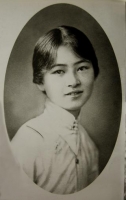| Township: | 福建省闽侯 | ||
| Birth Place: | 杭州 | ||
| Death Place: | 北京 | ||
Read works of Lin Huiyin at 诗海 | |||
BiographyLin was born in Hangzhou though her family was from Minhou, Fujian. She was the daughter of Lin Changmin (林長民) (16 September 1876 - Xinmin, Liaoning, 24 December 1925) and He Xuehuan (何雪媛) (1882–1972). Raised in a wealthy family, she received the best education a woman could obtain at the time. She pursued her degrees both in England and the United States. She attended St Mary's College in London, where she became acquainted with the well known Chinese poet Xu Zhimo. Their relationship is commonly referred to in a romantic anecdote. However, according to Lin, she had never fallen in love with Xu.
In April 1924, the sixty-four-year old Indian poet Tagore visited China, Lin Huiyin and Xu Zhimo worked together to do the interpretation work for Tagore, during which Lin Huiyin distinguished herself with her fluent English and also won the admiration of the great poet.
Lin studied art at University of Pennsylvania as an undergraduate, where she also worked as a part-time assistant in the architectural department. Later, she enrolled in stage design programs in Yale University as a graduate student, pursuing her longtime interest in drama.
Upon her return to China from the United States, she helped to establish the Architectural Department in Northeastern University in Shenyang, where she then taught architecture briefly. Meanwhile, in 1928, she designed a railway station in Jilin. This was one of the few buildings Lin designed.
Throughout the 1930s, Lin and her husband, Liang Sicheng, traveled in Shanxi, Shaanxi, Shandong, Hebei, Jiangsu, and other Chinese provinces to study and record architectural relics scattered throughout these provinces. In 1937, She discovered the main hall of Foguang Temple near Doucun, Shanxi. The hall was the only remaining Tang dynasty timber structure known at the time.
In 1936, in order to do the measurement work of the Chinese ancient architecture, Lin Huiyin together with Liang Sicheng climbed the quiet solemn roof of the Temple of Heaven. She is considered as the first woman in the history of China to set foot on the emperor worship palace roof.
After 1949, Lin and Liang Siceng was involved in the design of the National Emblem of the People's Republic of China and the Monument to the People's Heroes located in the Tiananmen Square. Lin designed the floral wreath patterns at the base of the Monument to the People's Heroes.
Lin Huiyin wrote poems, essays, short stories and plays. Many of her works were praised for its subtlety, beauty, and creativity. With her husband she wrote a book named History of Chinese architecture. She also translated English works into Chinese.
She died of tuberculosis.
Created by: 迪拜
